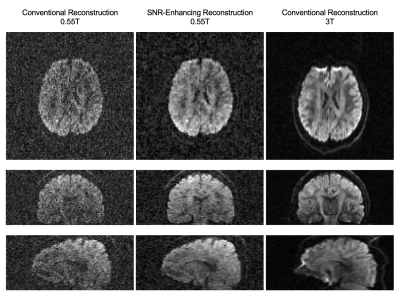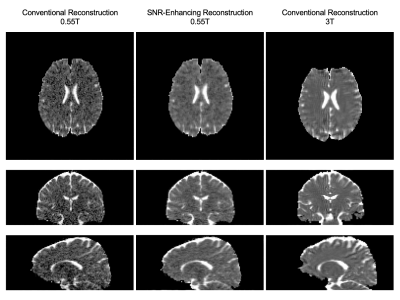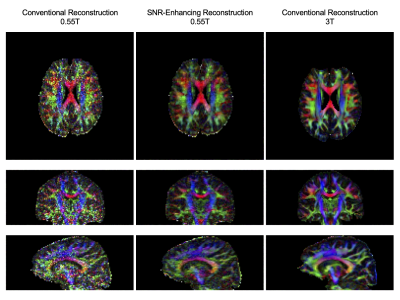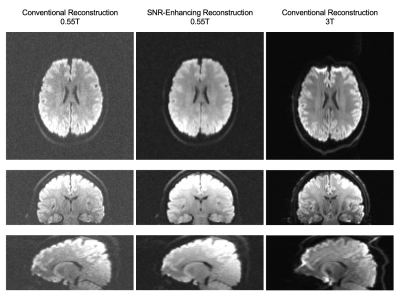3454
Diffusion Tensor Imaging of the Brain on a Prototype 0.55T System using SNR-Enhancing Joint Reconstruction1Signal and Image Processing Institute, University of Southern California, Los Angeles, CA, United States, 2Siemens Medical Solutions USA, Inc., Los Angeles, CA, United States, 3Brain and Creativity Institute, University of Southern California, Los Angeles, CA, United States, 4Department of Clinical Radiology, University of Southern California, Los Angeles, CA, United States
Synopsis
There has been substantial recent interest in MRI systems with lower $$$B_0$$$ field strengths, which can improve the value and accessibility of MRI. This work investigates the performance of diffusion tensor imaging on a prototype whole-body 0.55T system equipped with high-performance shielded gradients. Although the images suffer from noise contamination when using conventional image reconstruction techniques, we demonstrate that the use of an SNR-enhancing joint reconstruction technique can substantially reduce noise concerns, enabling high quality diffusion tensor imaging results. In addition, compared to diffusion data acquired on a conventional 3T scanner, the 0.55T images demonstrate substantially reduced susceptibility-induced geometric distortions.
Introduction
While the majority of modern human MRI platorms have field strengths that are $$$\geq$$$1 Tesla, there has been a recent surge of interest in modern high-performance MRI systems with lower field strengths.1-5 This interest has been motivated in part by the improvements in accessibility/portability and the potential cost reductions associated with lower field strengths, although the reduced signal-to-noise ratio (SNR) associated with lower $$$B_0$$$ is an obvious potential concern. SNR limitations are especially concerning for applications like quantitative diffusion MRI, where noise can be problematic even at higher field strengths.In this work, we investigate the potential of high-resolution diffusion tensor brain imaging on a prototype 0.55T MRI system, with direct comparisons against data acquired from the same subjects on a conventional 3T system. Compared to previous investigations at a similar field strength,2,6-8 we consider diffusion acquisitions with even higher spatial resolution.
To mitigate noise concerns, we employ an SNR-enhancing joint reconstruction (SER) approach that exploits the shared spatial structure of different diffusion images.9 Unlike denoising techniques that perform post-processing of already-reconstructed images, SER performs image reconstruction from k-space data and denoising simultaneously in a single step, leveraging multi-channel information and phase information to recover missing k-space information (e.g., due to partial Fourier acquisition) while also improving SNR. In addition, unlike many post-processing denoisers, SER has strong theoretical characterizations, and is associated with a well-understood (and provably-efficient) trade-off between spatial resolution and SNR. This allows users to tune this trade-off to meet their needs, without worrying that the reconstruction procedure might incorrectly introduce false features (hallucination) or incorrectly remove important real features (like subtle pathologies) from the data.9-12
Methods
Acquisition. Diffusion measurements were performed using a whole-body 0.55T system (prototype MAGNETOM Aera, Siemens Healthineers, Erlangen, Germany) equipped with high-performance shielded gradients (45 mT/m amplitude, 200 T/m/s slew rate) as well as a conventional 3T system (MAGNETOM Prismafit, Siemens Healthineers, Erlangen, Germany). Five volunteers were scanned, with diffusion data for each subject acquired twice on the 0.55T system and twice on the 3T system. At 0.55T, we acquired 64-direction diffusion data (b=1000 s/mm2, TE=90ms, TR=10000ms) with 2mm isotropic resolution (no parallel imaging acceleration, 6/8ths partial Fourier) using a 16-channel head and neck coil. At 3T, we used a similar 64-direction protocol (b=1000 s/mm2, TE=80ms, TR=10000ms) with 2mm isotropic resolution (no parallel imaging acceleration, 6/8ths partial Fourier) using a 20-channel head and neck coil.Reconstruction. Diffusion images were reconstructed jointly from k-space data by solving the following statistical (penalized maximum likelihood) problem formulation9:
$$\{\hat{\mathbf{p}}_1,\hat{\mathbf{p}}_2,\cdots,\hat{\mathbf{p}}_Q\}=\arg\min_{\{\mathbf{p}_1,\mathbf{p}_2,\cdots,\mathbf{p}_Q\}}\sum^Q_{q=1}\|\mathbf{E}_q\mathbf{p}_q-\mathbf{k}_q\|^2_2+J(\mathbf{p}_1,\mathbf{p}_2,\cdots,\mathbf{p}_Q),$$
where $$$\mathbf{p}_q$$$ is the $$$q$$$th diffusion-encoded image, $$$\mathbf{k}_q$$$ is the corresponding multichannel k-space data, and $$$\mathbf{E}_q$$$ is the forward model that incorporates phase information (for partial Fourier reconstruction) and coil sensitivity maps. The SER regularization penalty $$$J(\cdot)$$$ utilizes a shared compound Markov Random Field edge model that encourages the reconstructed images to be spatially smooth, with correlation between the edge locations of different images.9
Analysis. Diffusion images were processed using the BrainSuite diffusion pipeline.13 Specifically, diffusion tensor fitting was used to obtain mean diffusivity (MD) and fractional anisotropy (FA) values. In addition, we calculated trace images via geometric averaging of the diffusion-weighted images. We eventually plan to perform quantitative (Bland-Altman) statistical comparisons to assess the level of agreement and reproducibility of quantitative diffusion parameters across different field strengths and reconstruction methods, although only qualitative results are currently available to be presented in this abstract.
Results
Representative diffusion-weighted images (DWIs), MD values, and color-coded FA values from a single subject are shown in Figs. 1-3, respectively. Fig. 4 shows representative trace images from the same subject. As can be seen, the 0.55T DWIs obtained with conventional reconstruction are visually quite noisy, which leads to contamination of the MD and FA parameter maps. On the other hand, the results obtained with SER are substantially less contaminated by noise, as expected. Visually, there is much better correspondence between the 0.55T SER images and the 3T images than there is between the conventionally-reconstructed 0.55T images and the 3T images.Notably, the 0.55T images have substantially-reduced susceptibility-induced geometric distortion artifacts than the 3T images do, as expected from the lower field strength.
Conclusion
We investigated the performance of diffusion tensor imaging on a prototype 0.55T system, with comparisons against similar scans on a conventional 3T system. While SNR was a major limitation at 0.55T when using conventional reconstruction, the use of SER was able to substantially mitigate noise issues and produce high quality diffusion tensor imaging results. Notably, geometric distortion was also substantially reduced at the lower field strength.Acknowledgements
This work was supported in part by NIH grants R01-MH116173 and R01-NS074980, NSF grant CNS-1828736, the Ming Hsieh Institute for Research on Engineering-Medicine for Cancer, a USC Viterbi Graduate Fellowship, and research support from Siemens Healthineers.References
- M. Sarracanie et al. Low-cost high-performance MRI. Sci. Rep. 5:15177, 2015.
- A. E. Campbell-Washburn et al. Opportunities in interventional and diagnostic imaging by using high performance low-field-strength MRI. Radiology 293:384-393, 2019.
- J. P. Marques, F. F. J. Simonis, A. G. Webb. Low-field MRI: An MR physics perspective. J. Magn. Reson. Imaging 49:1528-1542, 2019.
- L. L. Wald et al. Low-cost and portable MRI. J. Magn. Reson. Imaging 52:686-696, 2019.
- J. P. Marques et al. ESMRMB annual meeting roundtable discussion: “when less is more: the view of MRI vendors on low-field MRI.” MAGMA 34;479-482, 2021.
- J. A. Stainsby et al. High-performance diffusion imaging on a 0.5T system. Proc. ISMRM 2019, p. 1193..
- C. N. Wiens et al. Feasibility of diffusion tensor imaging at 0.5T. Proc. ISMRM 2020, p. 303.
- G. Lemberskiy et al. Feasibility of accelerated diffusion weighted imaging for prostate cancer screening on prototype 0.55T system enabled with random matrix theory. Proc. ISMRM 2021, p. 742.
- J. P. Haldar et al. Improved diffusion imaging through SNR-enhancing joint reconstruction. Magn. Reson. Med. 69:277-289, 2013.
- J. H. Kim, S.-K. Song, J. P. Haldar. Signal-to-noise ratio-enhancing joint reconstruction for improved diffusion of mouse spinal cord white matter injury. Magn. Reson. Med. 75:852-858, 2016.
- J. P. Haldar, Y. Liu, C. Liao, Q. Fan, K. Setsompop. Fast submillimeter diffusion MRI using gSlider-SMS and SNR-enhancing joint reconstruction. Magn. Reson. Med. 84:762-776, 2020.
- C.-C. Chan, J. P. Haldar. Local perturbation responses and checkerboard tests: Characterization tools for nonlinear MRI methods. Magn. Reson. Med. 86:1873-1887, 2021.
- http://brainsuite.org/processing/diffusion/
Figures

Figure 1. A representative diffusion-weighted image from one of the subjects. We have chosen to show slices from the 0.55T and 3T results that depict similar (though not identical) anatomy.

Figure 2. A representative quantitative MD map from one of the subjects. We have chosen to show slices from the 0.55T and 3T results that depict similar (though not identical) anatomy.

Figure 3. A representative quantitative FA image from one of the subjects, where color-coding has been used to represent tissue orientation. We have chosen to show slices from the 0.55T and 3T results that depict similar (though not identical) anatomy.

Figure 4. A representative trace image from one of the subjects. We have chosen to show slices from the 0.55T and 3T results that depict similar (though not identical) anatomy.